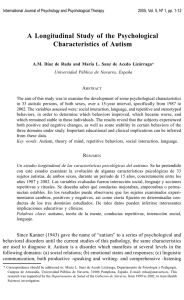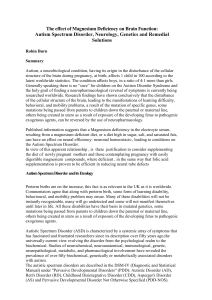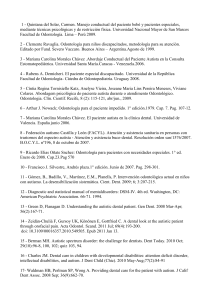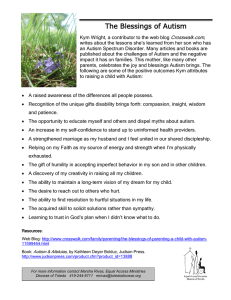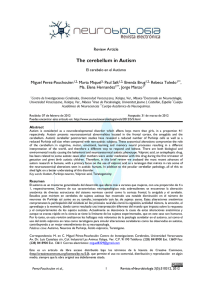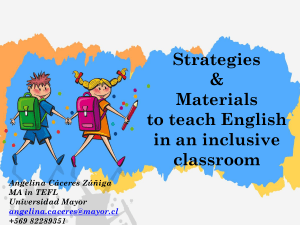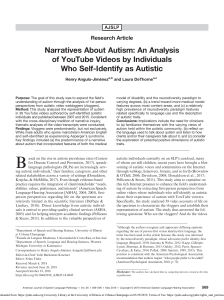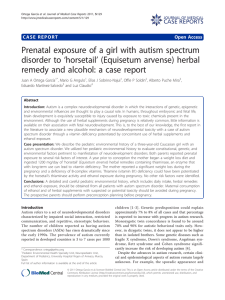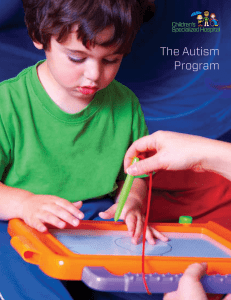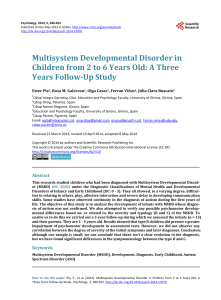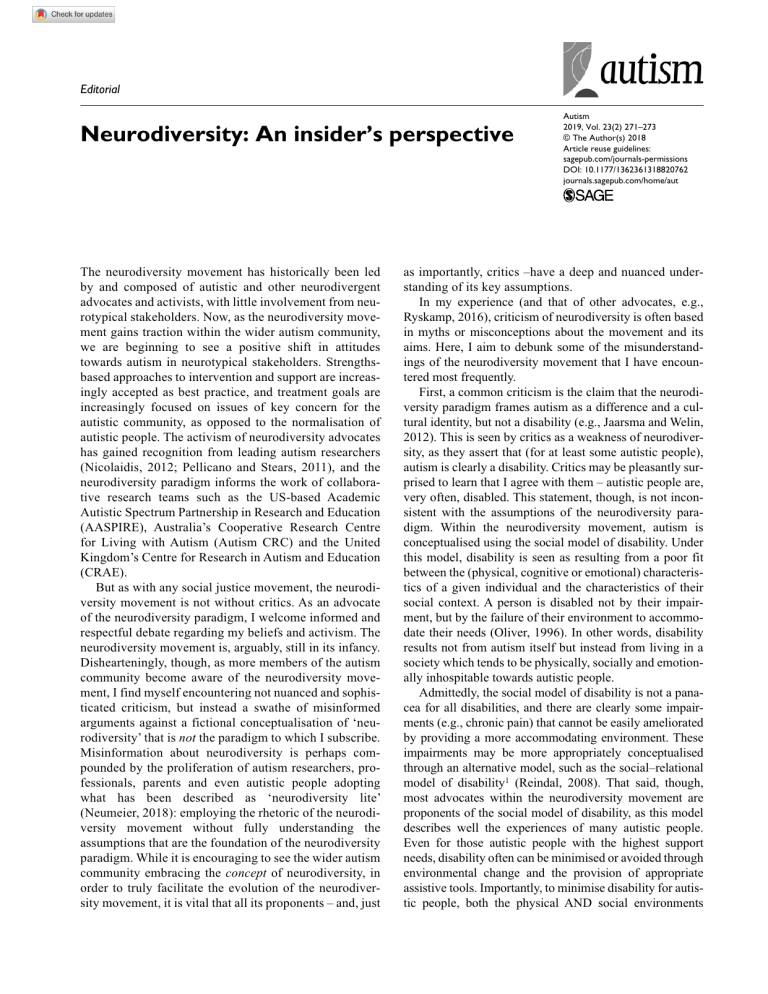
820762 editorial2018 AUT0010.1177/1362361318820762AutismEditorial Editorial Neurodiversity: An insider’s perspective The neurodiversity movement has historically been led by and composed of autistic and other neurodivergent advocates and activists, with little involvement from neurotypical stakeholders. Now, as the neurodiversity movement gains traction within the wider autism community, we are beginning to see a positive shift in attitudes towards autism in neurotypical stakeholders. Strengthsbased approaches to intervention and support are increasingly accepted as best practice, and treatment goals are increasingly focused on issues of key concern for the autistic community, as opposed to the normalisation of autistic people. The activism of neurodiversity advocates has gained recognition from leading autism researchers (Nicolaidis, 2012; Pellicano and Stears, 2011), and the neurodiversity paradigm informs the work of collaborative research teams such as the US-based Academic Autistic Spectrum Partnership in Research and Education (AASPIRE), Australia’s Cooperative Research Centre for Living with Autism (Autism CRC) and the United Kingdom’s Centre for Research in Autism and Education (CRAE). But as with any social justice movement, the neurodiversity movement is not without critics. As an advocate of the neurodiversity paradigm, I welcome informed and respectful debate regarding my beliefs and activism. The neurodiversity movement is, arguably, still in its infancy. Dishearteningly, though, as more members of the autism community become aware of the neurodiversity movement, I find myself encountering not nuanced and sophisticated criticism, but instead a swathe of misinformed arguments against a fictional conceptualisation of ‘neurodiversity’ that is not the paradigm to which I subscribe. Misinformation about neurodiversity is perhaps compounded by the proliferation of autism researchers, professionals, parents and even autistic people adopting what has been described as ‘neurodiversity lite’ (Neumeier, 2018): employing the rhetoric of the neurodiversity movement without fully understanding the assumptions that are the foundation of the neurodiversity paradigm. While it is encouraging to see the wider autism community embracing the concept of neurodiversity, in order to truly facilitate the evolution of the neurodiversity movement, it is vital that all its proponents – and, just Autism 2019, Vol. 23(2) 271­–273 © The Author(s) 2018 Article reuse guidelines: sagepub.com/journals-permissions https://doi.org/10.1177/1362361318820762 DOI: 10.1177/1362361318820762 journals.sagepub.com/home/aut as importantly, critics –have a deep and nuanced understanding of its key assumptions. In my experience (and that of other advocates, e.g., Ryskamp, 2016), criticism of neurodiversity is often based in myths or misconceptions about the movement and its aims. Here, I aim to debunk some of the misunderstandings of the neurodiversity movement that I have encountered most frequently. First, a common criticism is the claim that the neurodiversity paradigm frames autism as a difference and a cultural identity, but not a disability (e.g., Jaarsma and Welin, 2012). This is seen by critics as a weakness of neurodiversity, as they assert that (for at least some autistic people), autism is clearly a disability. Critics may be pleasantly surprised to learn that I agree with them – autistic people are, very often, disabled. This statement, though, is not inconsistent with the assumptions of the neurodiversity paradigm. Within the neurodiversity movement, autism is conceptualised using the social model of disability. Under this model, disability is seen as resulting from a poor fit between the (physical, cognitive or emotional) characteristics of a given individual and the characteristics of their social context. A person is disabled not by their impairment, but by the failure of their environment to accommodate their needs (Oliver, 1996). In other words, disability results not from autism itself but instead from living in a society which tends to be physically, socially and emotionally inhospitable towards autistic people. Admittedly, the social model of disability is not a panacea for all disabilities, and there are clearly some impairments (e.g., chronic pain) that cannot be easily ameliorated by providing a more accommodating environment. These impairments may be more appropriately conceptualised through an alternative model, such as the social–relational model of disability1 (Reindal, 2008). That said, though, most advocates within the neurodiversity movement are proponents of the social model of disability, as this model describes well the experiences of many autistic people. Even for those autistic people with the highest support needs, disability often can be minimised or avoided through environmental change and the provision of appropriate assistive tools. Importantly, to minimise disability for autistic people, both the physical AND social environments 272 require change, as attitudinal barriers to inclusion and acceptance are often significant. Providing a non-speaking autistic person with an alternative method of communication may give them a voice, but they will only truly stop being disabled when others listen. This brings me to a second criticism of the neurodiversity movement – the argument that the neurodiversity paradigm can only be appropriately applied to autistic people with lower support needs, often described as being ‘high functioning’, as those with higher support needs (described as ‘low functioning’) are generally considered by critics to be too significantly disabled to be included in the neurodiversity movement (Jaarsma and Welin, 2012; see also Fenton and Krahn, 2007). This critique appears to overlook an aspect of the autistic experience that many autistic people acknowledge but is often absent from the academic literature, that is, the considerable variation and fluctuation in both capability and capacity that autistic people experience. An autistic person may, for example, experience substantial impairment in one specific skill, but excel in another (perhaps closely related) skill, or may be perfectly able to perform a particular skill one day, only to find ourselves incapable of the same task on the next day. To dichotomise autistic people as ‘high functioning’ and ‘low functioning’ not only serves to erase these individual variations in ability, but can also be used to restrict access to support for those deemed ‘high functioning’, and to deny autonomy and agency to those deemed ‘low functioning’. Furthermore, the phrase ‘low functioning’ serves to lower expectations and, by extension, limit a person’s opportunities for success. Even if we were to set aside the belief that an individual is disabled by their social environment and instead adopt the medical model’s assumption that disability is inherent to an individual, it would arguably remain preferable to presume competence (i.e., to assume that a person has a given capability unless there is clear evidence to the contrary) and thereby provide an opportunity for achievement, rather than to presume incapacity and thereby stifle development. One key assumption of the neurodiversity paradigm is that all forms of neurological diversity are valuable, and that such diversity should be respected as a natural form of human variation (Walker, 2012). As such, neurodiversity explicitly includes all autistic and neurodivergent people, including those with the highest support needs. Indeed, their voices are some of the most influential within the neurodiversity movement (e.g., Sequenzia, 2012), although admittedly these voices are a minority within the advocacy community – just like in autism research and practice more broadly. This under-representation should not be interpreted as an indication that autistic people with high support needs are not valued by the neurodiversity movement, but instead reflects the work required to increase accessibility for people with Autism 23(2) high support needs across the autism community more generally. Perhaps the under-representation of autistic people with high support needs in the advocacy community can be attributed, at least in part, to the presumption within the wider community that such people are incapable of advocacy, and are therefore not given the means, support, self-belief or opportunities needed in order to be heard. A third criticism of the neurodiversity movement is that framing autism through the neurodiversity paradigm implies that autistic people do not require support, as neurodiversity would supposedly have us believe that autism is ‘just a natural variation’ (Jaarsma and Welin, 2012: 27, emphasis added). As already discussed, neurodiversity advocates generally consider autism to be both a natural variation and a disability. Advocates therefore concurrently campaign for acceptance and respect for autistic people as valuable members of society and also fight for appropriate support and services to meet the needs of the autistic community. Conflict between critics and neurodiversity advocates in the debate over support and interventions tends to centre on the end goal of such interventions. Critics often (either explicitly or implicitly) promote reducing or eliminating autistic traits as a key priority of intervention, and despite claims to the contrary (Jaarsma and Welin, 2015), many interventions for autism continue to have the reduction of core autism characteristics as their goal (see French and Kennedy, 2018). In contrast, the autistic community calls for services aimed at improving subjective quality of life and well-being while respecting and preserving autistic ways of being and, importantly, provided at the request and with the consent2 of the autistic person in question. In only a few decades, much progress has been made within the autism community. The autistic community has been tenacious in their advocacy, and in response, the research community has begun to reject long-held pathologising paradigms about autism. As an autistic autism researcher, I am encouraged to see the divide between my two communities being slowly breached. To build on this progress, it is vital that we begin to produce research that is informed by a sophisticated and nuanced understanding of the neurodiversity paradigm. But how best can we achieve this level of understanding? We turn to those with the insiders’ perspective on the neurodiversity paradigm, the community who created the paradigm and live by its values every day, and we work inclusively and collaboratively alongside those who our research stands to impact most – the autistic community. Notes 1. The social–relational model conceptualises disability as a combination of personal and social effects resulting from impairments, and social restrictions resulting from social barriers, which together function as oppression. Editorial 2. Not all autistic people are able to explicitly request or consent to certain supports or to make independent and fully informed decisions about the most appropriate supports to meet their needs. However, arguably the vast majority of autistic people are capable of having input, at some level, into decisions about the services that they receive – for example, all people can indicate their likes and dislikes, whether through speech, alternative methods of communication or behaviour. Regardless of the level at which they are able to engage in service planning, autistic people should be supported to contribute to these decisions to the fullest of their capabilities and their input should be respected and used to guide provision of supports. References Fenton A and Krahn T (2007) Autism, neurodiversity and equality beyond the ‘normal’. Journal of Ethics in Mental Health 2(2): 1–6. French L and Kennedy EMM (2018) Annual research review: early intervention for infants and young children with, or at-risk of, autism spectrum disorder: a systematic review. Journal of Child Psychology and Psychiatry 59(4): 444–456. Jaarsma P and Welin S (2012) Autism as a natural human variation: reflections on the claims of the neurodiversity movement. Health Care Analysis 20(1): 20–30. Jaarsma P and Welin S (2015) Autism, accommodation and treatment: a rejoinder to Chong-Ming Lim’s critique. Bioethics 29(9): 684–685. 273 Neumeier SM (2018) ‘To Siri with Love’ and the problem with neurodiversity lite. Available at: https://rewire.news/arti cle/2018/02/09/siri-love-problem-neurodiversity-lite/ Nicolaidis C (2012) What can physicians learn from the neurodiversity movement? American Medical Association Journal of Ethics 14(6): 503–510. Oliver M (1996) Understanding Disability: from Theory to Practice. Chatham: Mackays of Chatham. Pellicano E and Stears M (2011) Bridging autism, science and society: moving toward an ethically informed approach to autism research. Autism Research 4(4): 271–282. Reindal SM (2008) A social relational model of disability: a theoretical framework for special needs education? European Journal of Special Needs Education 23(3): 135–146. Ryskamp DA (2016) I’m a pro-neurodiversity advocate. Here’s what our critics never get right but don’t seem to care about, either. Available at: https://autisticacademic.com/2016/05/26/ im-a-pro-neurodiversity-advocate-heres-what-our-critics -never-get-right-but-dont-bother-to-correct-either/ Sequenzia A (2012) Non-speaking, ‘low functioning’. In: Bascom J (ed.) Loud Hands: Autistic People, Speaking. Washington, DC: The Autistic Press, pp.159–161. Walker N (2012) Throw away the master’s tools: liberating ourselves from the pathology paradigm. In: Bascom J (ed.) Loud Hands: Autistic People, Speaking. Washington, DC: The Autistic Press, pp.225–237. Jacquiline den Houting Macquarie University, Australia
